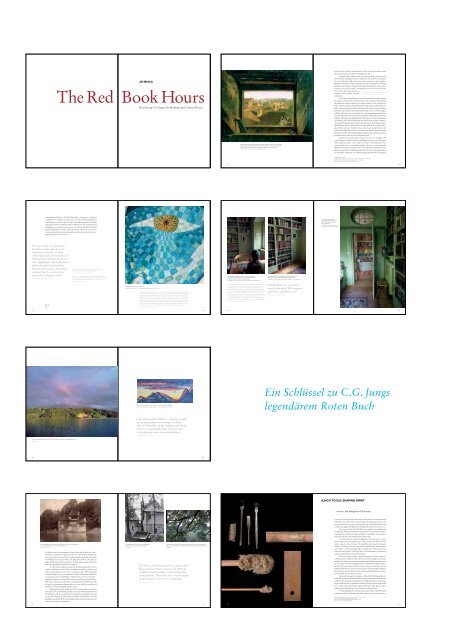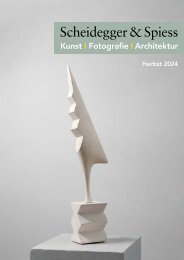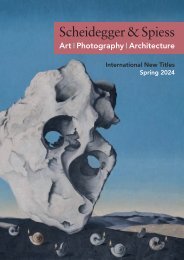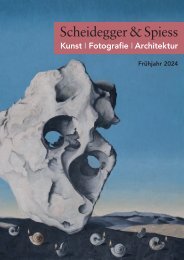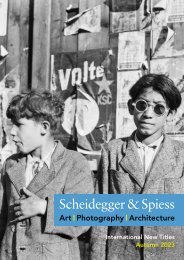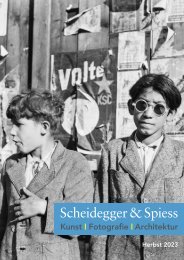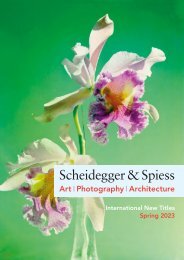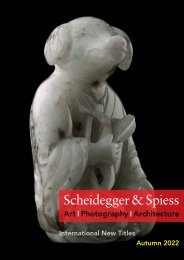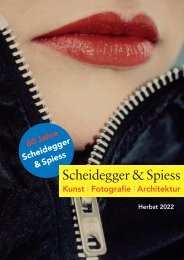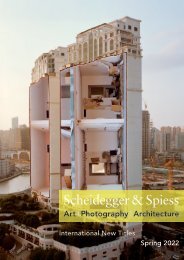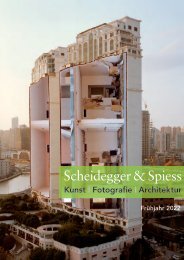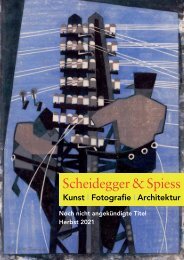Scheidegger & Spiess Vorschau Frühjahr 2018
Die aktuellen TItel vom Verlag Scheidegger & Spiess im Herbst 2018.
Die aktuellen TItel vom Verlag Scheidegger & Spiess im Herbst 2018.
Sie wollen auch ein ePaper? Erhöhen Sie die Reichweite Ihrer Titel.
YUMPU macht aus Druck-PDFs automatisch weboptimierte ePaper, die Google liebt.
–C. G. Jung, Memories, Dreams, Reflections, 199<br />
12 Ibid., 195<br />
13 Ibid., 223.<br />
14 Ibid.<br />
Jost Hoerni captures a well-lit view of one of the quarries from which Jung obtained stone.<br />
© Jost Hoerni<br />
Tower at Bollingen (shown here in a photograph by an unknown photographer<br />
in the early 1960s) can only be seen from the Obersee.<br />
© Jung Family Archives<br />
“The whole energy of these emotions was transformed<br />
into interest in and curiosity about the image.”<br />
–C. G. Jung, Memories, Dreams, Reflections, 187<br />
“What C. G. regarded as important was that people thought as<br />
the alchemists had done—they had certain experiences, and still<br />
have. He is interested in the experience, not in ‘proving.’”<br />
–Bennet, Meetings with Jung, 94<br />
Detail from The Red Book, page 133.<br />
© W. W. Norton and Company Used by permission of the Stiftung der Werke von C. G. Jung<br />
“Jung told Christina Morgan, as she recalls in her journal: ‘I should advise you to put it all<br />
down as beautifully & as carefully as you can—in some beautifully bound book. It will seem<br />
as if you were making the visions banal—but then you need to do that—then you are freed<br />
from the power of them. If you do that with those eyes for instance they will cease to draw<br />
you. You should never try to make that vision come again. Think of it in your imagination<br />
and try to paint it. Then when these things are in some precious book you can go to the book<br />
& turn over the pages & for you it will be your church—your cathedral—the silent places of<br />
your spirit where you will find renewal. If anyone tells you that this is morbid or neurotic<br />
and you listen to them—then you will lose your soul—for in that book is your soul.’”<br />
Douglas, Translate This Darkness, 159<br />
Detail from The Red Book, folio iv verso, col. 1 (The slaying of Siegfried).<br />
© W. W. Norton and Company Used by permission of the Stiftung der Werke von C.G. Jung<br />
–Jung, Memories, Dreams, Reflections, 7<br />
A partial view of the Tower, with the lake behind it,<br />
shows the structure as it appeared in 1983.<br />
© Jill Mellick<br />
–Hannah, Jung, His Life and Work, 153<br />
A great tree branch leans over the Obersee. Wood is constantly being washed up<br />
onto the shore at Bollingen, and trees on the grounds also require constant cutting.<br />
© Jill Mellick<br />
Landscape from a Dormer by Sebastian Gutzwiller d’Alsace, 1835‚ was one of the few<br />
paintings in Jung’s childhood home in Klein-Hüningen. Most of Gutzwiller’s life was<br />
spent in Basel; his work included altarpieces, portraits, and genre paintings.<br />
© Jung Family Archives By permission of the Jung Family Archives<br />
Jung designed a standing desk for The Red Book, which<br />
The standing desk Jung installed to accommodate The Red<br />
he would have installed in the space behind the desk and<br />
Book was built in after the original building was finished.<br />
desk chair where his visionary journey began.<br />
© Jill Mellick Used with permission from the Stiftung C. G. Jung Küsnacht<br />
© Jill Mellick Used with permission from the Stiftung C. G. Jung Küsnacht<br />
“It was during Advent of the year 1913—December 12, to be exact—that<br />
I resolved upon the decisive step. I was sitting at my desk once more,<br />
thinking over my fears. Then I let myself drop. Suddenly it was as<br />
though the ground literally gave way beneath my feet, and I plunged<br />
down into dark depths. I could not fend off a feeling of panic. But then,<br />
abruptly, at not too great a depth, I landed on my feet in a soft, sticky<br />
mass. I felt great relief, although I was apparently in complete darkness.<br />
–Andreas Jung, personal communication, 2012.<br />
After a while my eyes grew accustomed to the gloom, which was rather<br />
like a deep twilight. Before me was the entrance to a dark cave, in<br />
which stood a dwarf with a leathery skin, as if he were mummified.”<br />
–Jung, Memories, Dreams, Reflections, 179<br />
From the desk and chair in<br />
the study, one has a view of the<br />
short hall leading into the main<br />
part of the library.<br />
© Jill Mellick Used with permission<br />
from the Stiftung C. G. Jung Küsnacht<br />
4 Csikszentmihalyi, Creativity.<br />
5 Jay Sherry in Carl Gustav Jung, and Sonu Shamdasani in his Introduction to The Red Book,<br />
provide a discussion of Jung’s exposure to cultural and artistic influences.<br />
6 Shamdasani, Introduction to C. G. Jung, The Red Book, 196.<br />
—Henri, in Artists on Art, 401<br />
69 Dots (pricks) resembling pencil dots are visible in the facsimile edition of “Liber<br />
71 One such container is preserved at Bollingen.<br />
“I was on the way to discovering my own myth.”<br />
–C. G. Jung, Memories, Dreams, Reflections, 174<br />
Jill Mellick<br />
The Red Book Hours<br />
Discovering C. G. Jung’s Art Mediums and Creative Process<br />
pencil. Except for cloth, the materials he used to create his manikin would<br />
prove to be his primary mediums throughout his life.<br />
Deemed utterly without talent at a young age, Jung recognized even<br />
then that drawing sightless busts (as required in school) held no inspiration<br />
for him and that he could only make art that came from an inner impulse.<br />
Whether making his manikin or painting on stone or drawing tiny, infinitely<br />
detailed armies in pencil, he pleasurably absorbed himself in a process that<br />
took him out of time. It held a compelling attraction for him. His early<br />
immersion in the creative process is<br />
common among highly creative<br />
individuals. 4<br />
Viewing art and painting were important experiences for Jung, though<br />
his studies at the University of Basel and his early professional work limited<br />
the amount of time he could devote to these pursuits. In his youth he was<br />
drawn to Swiss, German, and Dutch painters, both representational and symbolic.<br />
5 During his medical studies, his natural talent for drawing would have<br />
been diverted to medical drawings and histology. And it would be highly<br />
unlikely if Jung had not encountered the stunning paintings produced by<br />
Ernst Haeckel, the German naturalist, physician, philosopher, and marine<br />
biologist. Although none of Jung’s medical drawings survive, he was fascinated<br />
by histology, which required the highly developed visual capacity to differentiate<br />
tissues. He had always been intensely interested in natural history and its<br />
representation. After a period working at the Burghölzli, the psychiatric hospital<br />
of the University of Zürich, he used his time studying in Paris with<br />
French psychologist Pierre Janet to visit the Louvre. He also visited the British<br />
Museum in London. He bought paintings and engravings, and he also ordered<br />
paintings copied, which he used to furnish his home. 6<br />
Jung was not simply appreciating art; he was also making it. He<br />
worked in pencil, chalk, transparent and opaque watercolors, and oils. Some<br />
of his landscapes appear to be en plein air. Other works might have been<br />
reconstructed from in situ sketches, memory, fantasy, or other artworks.<br />
While his transparent watercolors are not as skillful as his pastels and oils,<br />
they have a spontaneity and freshness that allow the viewer some appreciation<br />
for the delight, absorption, and enthusiasm Jung must have felt as he painted<br />
48 49<br />
contemplate, and theorize. The Red Book itself—startling as it is, and now<br />
available to all—is simply one among scores of visual works Jung created in<br />
relationship to his inner world. It is part of his lifelong practice of carefully<br />
choosing particular art mediums as the most fitting way—for a particular time<br />
and purpose—to express or gain access to his inner world. He himself best<br />
describes his lifetime of work, visual and written: “My works are a more or<br />
less successful endeavor to incorporate this incandescent matter into the contemporary<br />
picture of the world….” 14<br />
“ The years when I was pursuing<br />
my inner images were the most<br />
important in my life—in them<br />
everything essential was decided. It<br />
all began then; the later details are<br />
only supplements and clarifications<br />
of the material that burst forth<br />
from the unconscious, and at first<br />
swamped me. It was the prima<br />
materia for a lifetime’s work.”<br />
“ The Red Book was not closed<br />
away. It was open. When patients<br />
came, they could look at it.”<br />
62 63<br />
84 85<br />
Ein Schlüssel zu C.G. Jungs<br />
legendärem Roten Buch<br />
“ I was informed that children as small as I could<br />
not go along, there was nothing to be done<br />
about it. From then on the Uetliberg and Zürich<br />
became an unattainable land of dreams, near<br />
to the glowing, snow-covered mountains.”<br />
100 101<br />
JUNG’S TOOLS: SHAPING SPIRIT<br />
…a trace, the footprint of the state.<br />
is visible witness to the emergence of inner visions and symbols into form—<br />
and each is a monument to Jung’s need to renew his spirit in timelessness,<br />
introversion, silence, natural beauty, and structured, intentional conviviality.<br />
At Bollingen more than anywhere else, Jung built, dwelt in, and protected<br />
spaces that let his soul dive and surface. A multimedia artwork in itself, the<br />
Tower was the physical matrix for his creativity.<br />
In 1923, in the middle of making The Red Book, Jung felt the need to<br />
“make a confession in stone.” He found lakefront land he could buy and<br />
began to build his now-iconic Tower, extending it until 1955. If Jung had<br />
involved himself in every centimeter of his house in Küsnacht, he did so to<br />
an even greater extent with Bollingen. He allowed it to evolve over decades—<br />
and he knew when it was finished. On its outer walls Jung chiseled bas-reliefs,<br />
some symbolic, some decorative, some familial; in its lakeside grounds<br />
he carved a freestanding sculpture; and on its inner walls he created more if<br />
smaller bas-reliefs and painted complex murals.<br />
Bollingen became the wellspring for his creative output, and he went<br />
there to renew for periods during the last seven years of his Küsnacht work on<br />
The Red Book, and the rest of his life. For decades, he worked there on stone<br />
carving and wall painting. The earliest year that he ordered colors for his wall<br />
paintings was probably 1923, so he was beginning his wall paintings at the same<br />
time he was painting The Red Book.<br />
“ The Tower was built primarily as a place where<br />
Jung could be ‘reborn in stone,’ and where he<br />
could be entirely himself, ‘a place of spiritual<br />
contemplation.’ There were also ‘concrete needs<br />
of the moment’ from the very beginning.”<br />
A trace of the artist’s process, the footprint of his state of consciousness and<br />
skills often lies in the tools he used. For Jung, the right materials and tools<br />
were essential for every type of artistic medium he used. Self-taught in each<br />
medium, he sought and bought the finest pigments and also the finest tools.<br />
His many tools for The Red Book were specific to its considerable<br />
requirements. While the finished product renders the mechanics of production<br />
relatively invisible, in fact Jung would have assembled a wide variety of<br />
tools with which to make his illuminated manuscript.<br />
In the tradition of medieval calligraphers, he used an awl to prick<br />
several pages at once in preparation for ruling. 69 Then he would have used a<br />
ruler, a compass, and a protractor. He needed fine sable brushes with good<br />
“bellies” to hold the color mix generously and predictably: round brushes<br />
with a fine toe or tip for painting small areas; flat brushes with crisp ends and<br />
corners for larger areas; 70 and script, liner, or detail brushes for miniature<br />
work, particularly dots and hand-drawn lines.<br />
Daily necessities included a pencil-sharpening tool; heavy paper or<br />
cardboard to place under his hand to protect work from smudges, stray paint,<br />
and hand oils; glass water containers for dipping and cleaning brushes; and at<br />
least one glass container for dipping the toe of his brush to dilute pigment<br />
mixtures. He also needed at least one tall container in which to store his<br />
brushes handle down in order to ensure that they would hold their shapes as<br />
they dried. For paints he had already mixed, he needed sealable glass containers<br />
to keep the mixes wet between uses. 71<br />
Jung used high-quality pigments with both unflinching generosity<br />
and steady parsimony. He finished bag upon bag to the last grain. Because he<br />
made his paints using mineral pigments with high specific gravity, these pigments<br />
would sink out of suspension between painting sessions; Jung would<br />
have to shake each sealed mixture vigorously before using it again to redistribute<br />
the mineral particles evenly in the gum arabic and water.<br />
For his calligraphy he would have chosen special pens made from quill<br />
or having metal nibs. Sometimes he used his fountain pen for capital letters.<br />
Secundus.” Hugh Milstein, personal communication, 2012.<br />
70 Jung might also have used bright brushes with narrowed corners.<br />
96 97<br />
122<br />
123


